|
 January 21, 2022
|
|
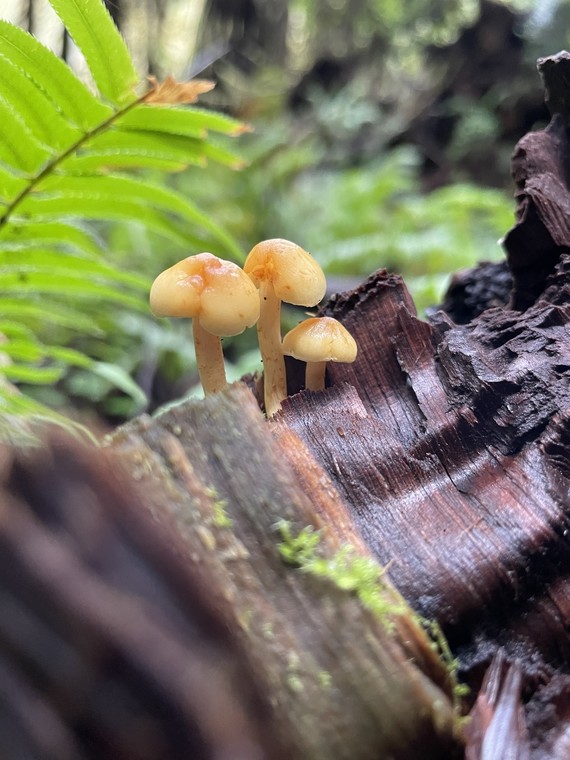 Prairie Creek Redwoods State Park
Dainty mushrooms emerging from wood.
Photo from Christine Odson, North Coast Redwoods District

|
|
State Parks Works With Private Contractor and Nonprofit to Remove Abandoned Sailboat From Emerald Bay
Story from: Silver Hartman, Sierra District
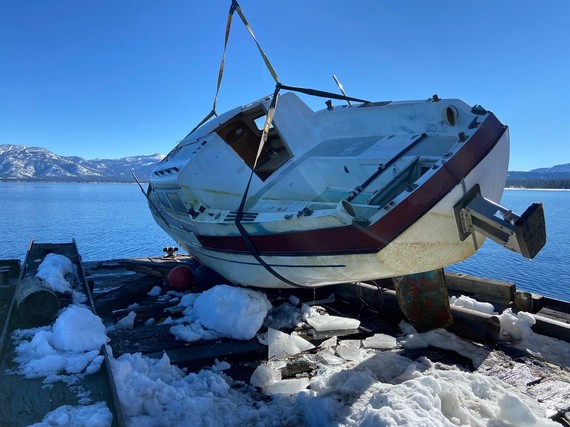 Snow complicates barge and removal access to extract abandoned boats in winter conditions. Photo from Seth Jones, Marine Taxonomic Services.
Recognizing the potential and significant environmental damage an abandoned boat can cause, Sierra District, along with environmental consulting firm Marine Taxonomic Services and nonprofit Below the Blue, teamed up to clean out and dispose of a sailboat left in Emerald Bay.
Sierra District Ranger Kathy Searl reported the abandoned sailboat to Senior Environmental Scientist Dan Shaw in early November 2021. Numerous attempts had already been made to find the owners and have them take responsibility for the vessel—all to no avail. After additional repeated attempts, it became clear the owners would not assume responsibility. Eventually the sailboat broke free from a mooring, drifted across the bay and ran ashore along a rocky and inaccessible bank. With a strong, impending December storm approaching, Sierra District staff worked with private contractor Marine Taxonomic Services (MTS) and their sister nonprofit organization Below the Blue to ensure all the loose items on the sailboat were safely removed. Sierra District and MTS have been working together for over a decade to protect Emerald Bay and Lake Tahoe with educational and cleanup efforts such as Below the Blue and highly effective aquatic invasive control work in Emerald Bay and beyond. This partnership was essential for quick action to successfully remove this abandoned sailboat.
Seth Jones and Monique Rydel-Fortner from Below the Blue donated their time to remove over 3,000 pounds of loose debris on the sailboat. They hauled ropes, the mast, railings, trash, oils, chemicals, fuel, sewage, spoiled food, piles of beer cans and liquor bottles, numerous personal items, as well as any loose parts they could remove from the boat back to land for recycling or disposal. At this point the boat had tipped over and was drifting and bouncing off rocks along the shore. Without this donation of time and effort, these items could have easily and significantly polluted Emerald Bay during the December storms that hit the Lake Tahoe Basin.
During this time, the Sierra District pieced together limited funding for MTS to remove the entire vessel. On Sunday, January 9, Seth and Monique teamed up with a barge and crane operator Jim Amundson from South Lake Tahoe to lift the sailboat out of the water and bring it back in for disposal. By this time there were numerous large holes in the sailboat, confirming that the previous efforts to remove all hazardous materials and loose debris were not done in vain. Subsequent dives were completed in the area to remove additional under water debris.
Sierra District will continue to work with MTS and other Tahoe Basin partners on a long-term solution and funding mechanism to deal with abandoned boats quickly and effectively.
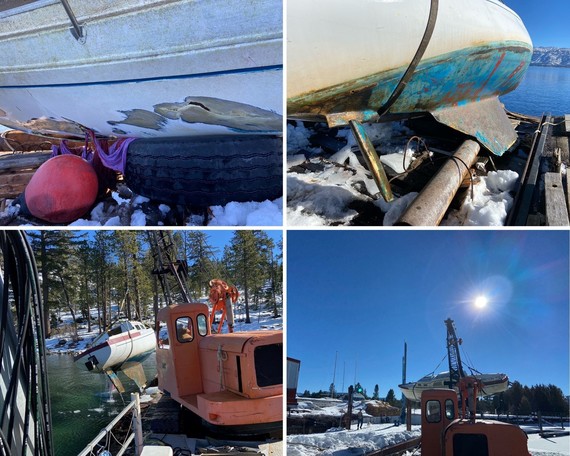 Top left: Quick action was necessary because the abandoned boat was breaking apart on the rocks and polluting Emerald Bay. Top right: Securing abandoned boat to the barge. Bottom left: Barge and lift operator Jim Amundson stepped up in a big way to help. Snow complicates barge and removal access to extract abandoned boats in winter conditions. Bottom right: Offloading abandoned sailboat in the marina in South Lake Tahoe. Photos from Seth Jones, Marine Taxonomic Services.
 WHAT'S NEW
California Academy of Sciences Opens New Outdoor Play Area, Wander Woods
Story from: Communications and Marketing Division
 The new Wander Woods at the California Academy of Sciences in San Francisco's Golden Gate Park.
Aligning with California’s efforts to help provide open space for children to better connect with the outdoors and recognizing the importance of nature for overall well-being, the California Academy of Sciences museum in San Francisco’s Golden Gate Park recently opened an outdoor play area, Wander Woods.
Opened on Friday, January 14, in the museum’s East Garden, Wander Woods offers multisensory discovery and learning opportunities through areas dedicated to crawling, climbing and other imaginative play activities—all outdoors beneath old-growth cypress trees. Winding pathways take visitors on an exploration of the garden, revealing a hands-on area where guests can build their own den from natural materials, a space for nature-driven creativity and honing fine motor skills, a log tunnel to crawl through and a hillside nest and perch that provides a thrilling new view of the entire garden.
Constructed from locally sourced materials like salvaged tree trunks, Wander Woods features a variety of stroller- and wheelchair-accessible play spaces that offer visitors an immersive way to explore the natural world. From observing a bug crawl to balancing on a log, Wander Woods promotes inquiry-based activities that nurture collaboration and complex reasoning. Although the play area is ideal for children up to 12 years of age, guests of all ages can reflect, recharge and reawaken their connection to nature in the Academy’s newest outdoor space.
In addition to self-directed outdoor play that stretches the body and opens the mind to creative thinking and problem-solving, Wander Woods will feature pop-up facilitated nature play activities and seasonal public programs.
To learn more, click here to read the California Academy of Sciences press release.
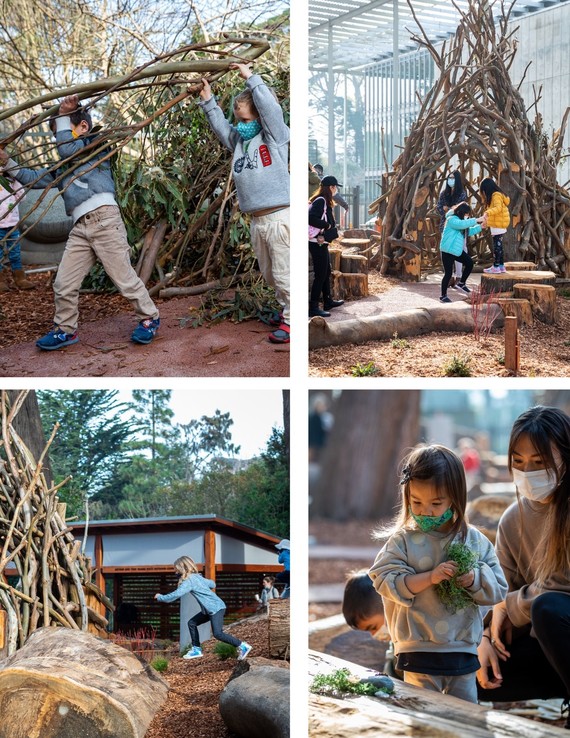 Kids explore some of the fun, interesting activities at Wander Woods.
 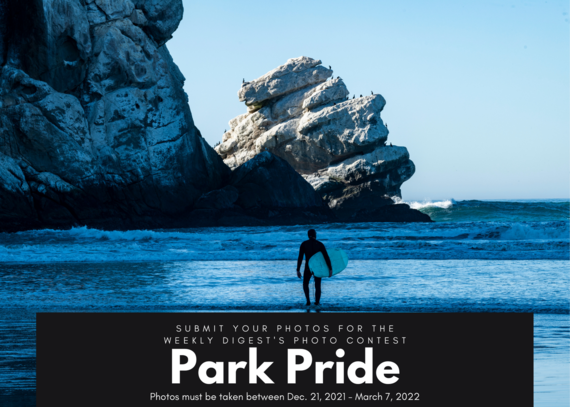 Email photos to the WeeklyDigest@parks.ca.gov.
  
|
|
|
To view current job openings within California State Parks, please visit our jobs webpage at www.LiveTheParksLife.com.
State Parks Job Spotlights and Open Exams
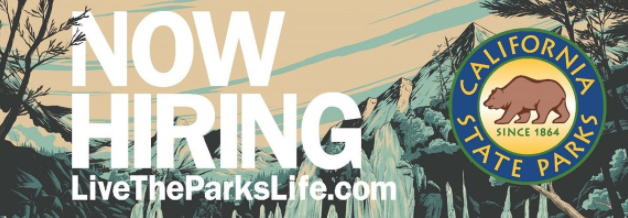 Do you enjoy the outdoors? Do you have a passion for preserving the state’s extraordinary precious resources? If you said “yes,” California State Parks has many exciting and rewarding careers perfect for you to explore.
JOB SPOTLIGHTS
Associate Park and Recreation Specialist – Apply by Jan. 23, 2022: Live the Parks Life as an Associate Park and Recreation Specialist in the Santa Cruz District! This position will provide outdoor recreation-related specialist services for the district’s planning, special events and concessions program. Take the online exam and apply today! Click here for more information.
Park Interpretive Specialist (Seasonal) – Apply by Jan. 27, 2022: We have an exciting part-time opportunity to work as a Park Interpretive Specialist (Seasonal) at the spectacular Hearst San Simeon State Park. Apply today to assist in planning, coordinating, implementing and delivering interpretive and educational programming, such as the northern elephant seal interpretation program and the open ocean kayak programs. No exam needed. Click here for more information.
Maintenance Mechanic – Apply by Feb. 3, 2022: Your skills are needed as a Maintenance Mechanic in the Russian River Sector. This position will work on water and sewage, LPG, high-voltage electrical, low-voltage electrical, solar electric, gasoline pumps, HVAC and alarm systems. Take the online exam and apply today. Click here for more information.
Senior Park Aide – Now hiring! Your Parks office view can be the beautiful Hollister Hills State Vehicular Recreation Area. Apply to lead interpretive programs such as Junior Rangers, guided walks, evening programs, field programs at riding destinations (booths/pop-up/trailer), public outreach programs, informal roving interpretation and school group programs. No exam needed. Click here for more information.
EXAM SPOTLIGHTS
Aquatic Pest Control Technician Exam – Apply by Feb. 1, 2022: If you have six months of experience in pest control work or 60 college credits with course work in biology, apply to take the Aquatic Pest Control Technician exam today. Click here for more information.
Aquatic Pest Control Specialist Exam – Apply by Feb. 1, 2022: If you have three years of experience in pest control and a Qualified Applicator Certificate (or are in the process of obtaining one), apply to take the Aquatic Pest Control Specialist exam today. Click here for more information.
Associate Park and Recreation Specialist Exam – Take the exam today! The Associate Park and Recreation Specialist exam is now online and continuous. From grant administration to outdoor education, the opportunities as an Associate Park and Recreation Specialist are endless. Click here for more information.
If you have any questions regarding these opportunities, connect with us at recruiting@parks.ca.gov. We’re happy to help!
Interested in learning more about job opportunities and exams? Explore www.LiveTheParksLife.com to discover the possibilities.
Join the Parks Jobs mailing list here! We can send you updates on jobs and exams that interest you.
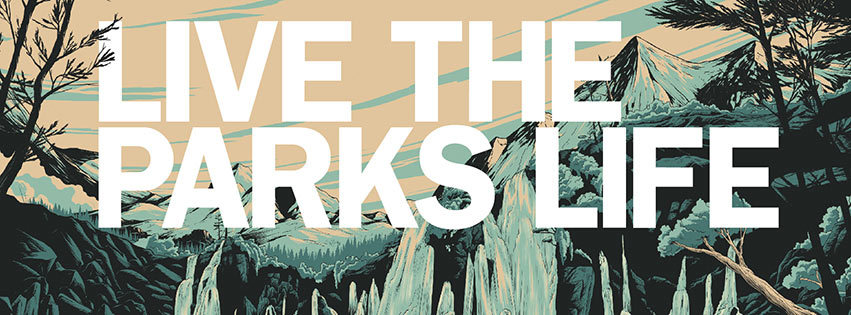 
|
|
|
Style time! Here are this week's tips to help spread the word about our departmentwide style guidelines:
-
cross-country: Always use a hyphen, whether used as an adjective, adverb or noun.
-
nonprofit: One word, no hyphen. Words that have the prefix “non” are generally not hyphenated. Exceptions include if it is used before a proper noun, before a compound word or if would create double consonant (e.g., non-native).
-
State Park System: Uppercase since means entire inventory of California State Parks.
Keeping a consistent writing style ensures the Weekly Digest looks and sounds its best. Each week, the Communications and Marketing Division reviews submitted articles for proper grammar and punctuation and style consistency––from capitalization and hyphenation to proper acronyms and active/passive voice usage. In general, we follow the Associated Press style and Merriam-Webster, but at times we use our own department-specific style.
We always welcome your feedback on how to “Live the Parks Life” in (writing) style. Connect with us via email at weeklydigest@parks.ca.gov.

|
|
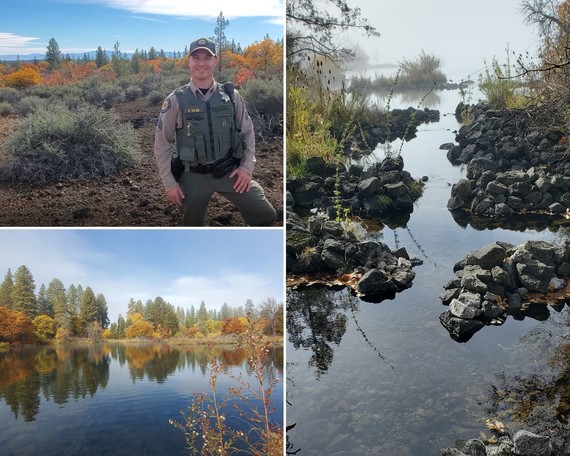 Ahjumawi Lava Springs State Park
Different views of the northeastern California's volcanic landscape of the park. Top left: Supervising Ranger Ryan Rzab.
Photos from Jennifer Pooley, Northern Buttes District
 Marshall Gold Discovery State Historic Park
In July 2021, an oak tree split dropping a large branch on the sign for St. John’s Catholic Church at the historic park. The maintenance crew went to work to recreate the sign, employing the services of Jill Jones, a former senior park aide, to paint the new sign. On Wednesday, January 12, Heavy Equipment Operator Chris Connolly came over from Auburn State Recreation Area to help set the telephone poles that would hold the sign. Worker I Ian McWherter put on the safety straps and guided the lift to place the sign, while Worker I Derek Kettenhofen made the assist from a ladder. Soon it was again in place, looking better than before. St. John’s Catholic Church was established in 1856 and is rented for weddings and special events.
Photos from Jerrie Beard and Patrick Metcalf, Gold Fields District
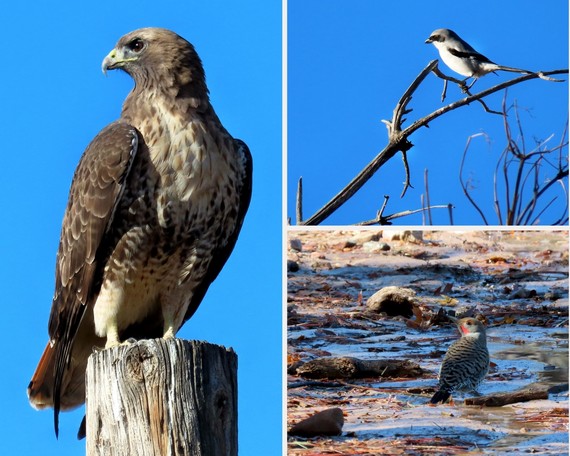 Cuyamaca Rancho State Park
A trio of birds from the park. Left: Red-tailed hawk. Top right: Loggerhead shrike. Bottom right: Northern flicker.
Photos from Michele Hernandez, Colorado Desert District
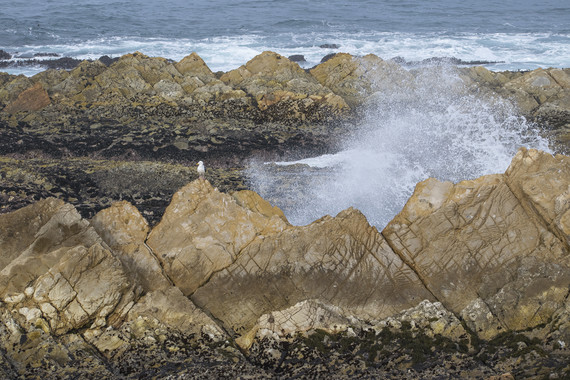
Montaña de Oro State Park
A gull stands nonchalantly while ocean waves crash and spray against the rocks.
Photo from Amber Rack, San Luis Obispo Coast District
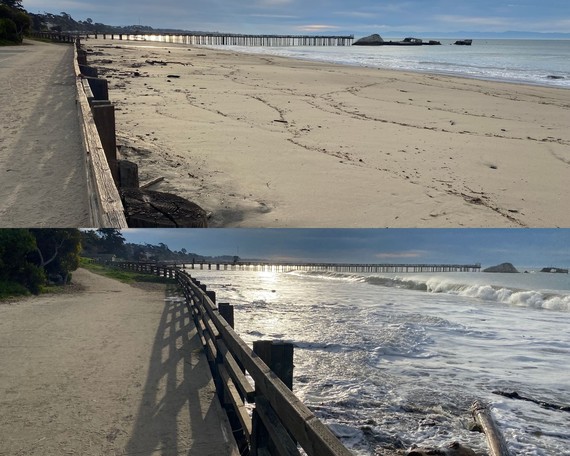 Seacliff State Beach
Showing the impacts from the tsunami originating from the Tonga volcanic eruption before and after on Saturday, January 15. Top photo: Taken at 8:30 a.m. Bottom photo: Take at 8:47 a.m.
Photos from Gabe McKenna, Santa Cruz District
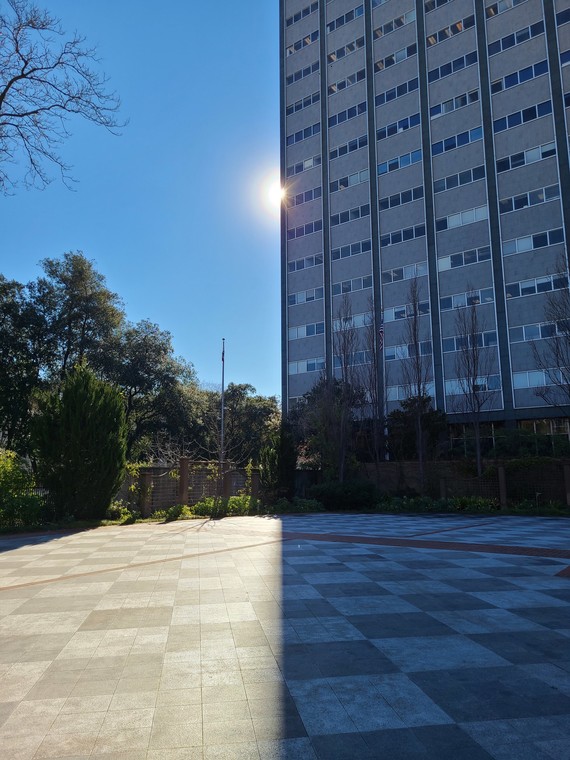 Former Natural Resources Building
and Leland Stanford Mansion State Historic Park
The light side and the dark side. During the winter, the former Natural Resources building blocks the sun from the Stanford Mansion. This is an early morning view from the mansion courtyard as the sun begins to hide behind the building, casting a shadow that makes it a little colder at the site.
Photo from Megan Stanley, Capital District
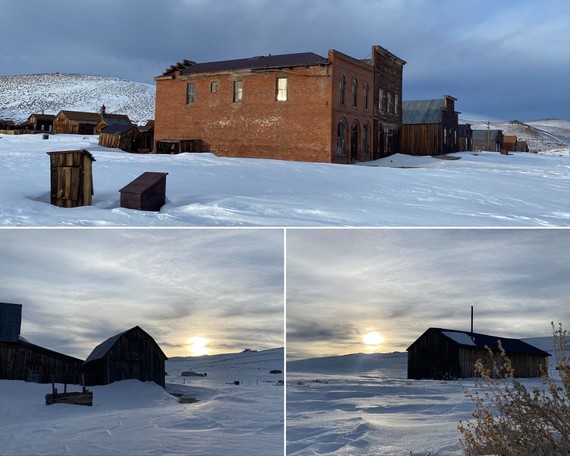 Bodie State Historic Park
The afternoon of Tuesday, January 11, with its clouds and warmth, made the snow shiny.
Photos from Hillary Colyer, Sierra District
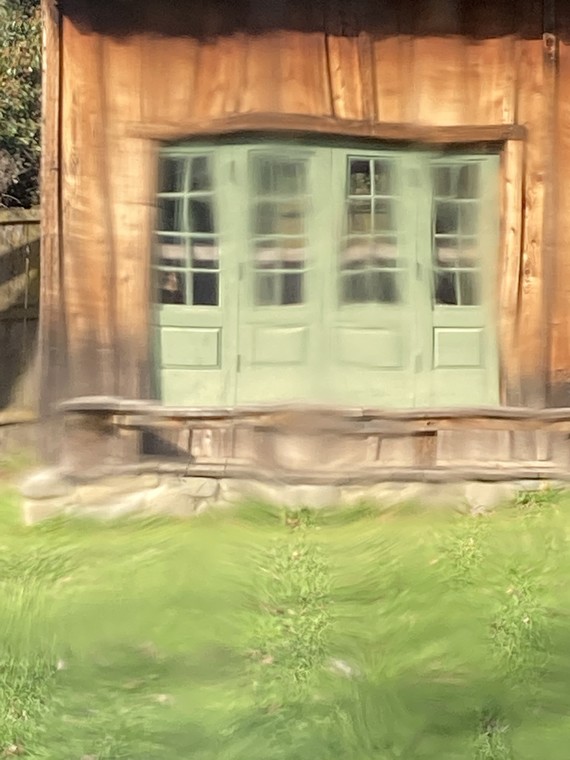 William B. Ide Adobe State Historic Park
Have you ever wondered why old window glass is wavy? In the mid-19th century, window glass was handblown into large cylinders. Artisans in Europe and on the East Coast of the United States would use a long blowpipe with a ball of molten glass on the end while swinging the pipe into a pit as the glass elongated to the desired length and diameter. It resembled a cylinder. After the glass cooled, it would be cut, then reheated in a furnace to flatten it out. It is this reheating process that gives the glass its wavy appearance. After the 1900s, different methods of production were used, and glass was produced more locally; e.g., a glass factory in Stockton opened in 1902.
Last fall, maintenance staff at the park worked to restore and replace broken window panes in the Adobe House with wavy glass used during the 1800s. This is a photo of the woodshop taken through a wavy window in the historic Adobe.
Photo from Heather Lee, Northern Buttes District
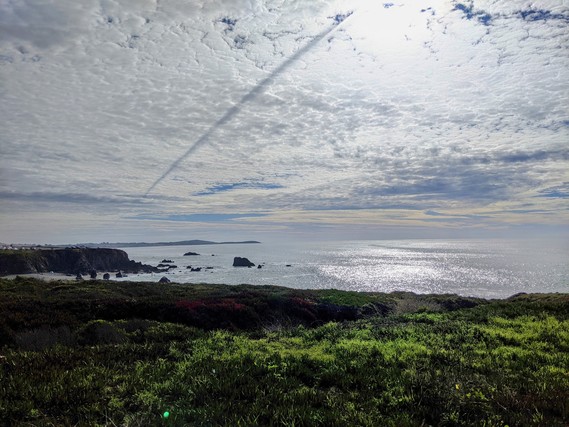 Sonoma Coast State Park
An airplane condensation trail casting a shadow on the clouds above the park.
Photo from Alexander Ramm, Sonoma-Mendocino Coast District
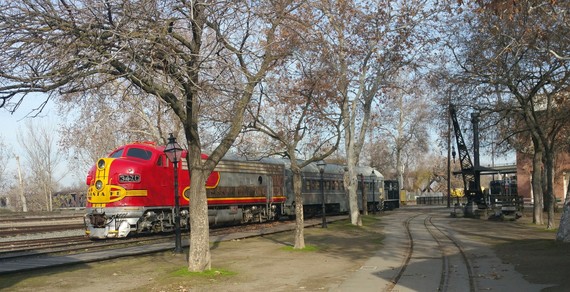 California State Railroad Museum
The Santa Fe 347C was looking mighty fine on the tracks Thursday, January 13, and I had to snap a photo. I ran into Chief Operating Officer Ilias Athanasiou, who informed me he had spent the last four days cleaning and waxing it. This was the best it has looked in 30 years! I think he did a great job.
Photo from Wendy Sanchez, Capital District
  Email photos to the WeeklyDigest@parks.ca.gov.
|
|
|
The Weekly Digest includes a collection of news articles related to the
California Department of Parks and Recreation. The views expressed and opinions do not always reflect that of the department.
To view this week's News Clips, please click here.
  Weekly Digest Article and Photo Submissions
If you have an article or photo you would like to submit for the Weekly Digest, please send your entries via email to WeeklyDigest@parks.ca.gov.
For an article submission, please include:
- Author’s name and division/district.
- All relevant information (e.g., headline, park name, dates, name of event, individuals’ full names and titles, etc.).
Articles should be no longer than 300 words.
For photos, please include:
- Photo credit info and captions.
- Photo release forms should be kept on file for non-employees or volunteers.
Unless otherwise noted, all photos included in the Weekly Digest are courtesy of the California Department of Parks and Recreation.
The deadline for Weekly Digest submissions is close of business Thursday. For more information, email WeeklyDigest@parks.ca.gov.
|
|
|
|
|